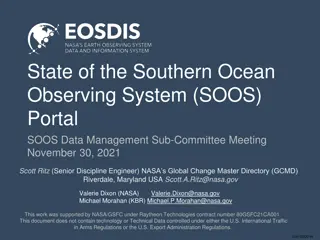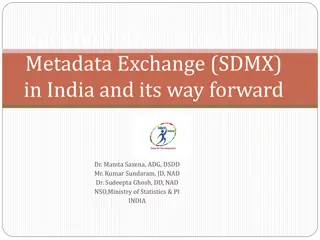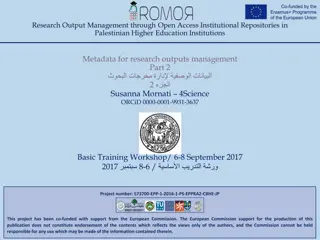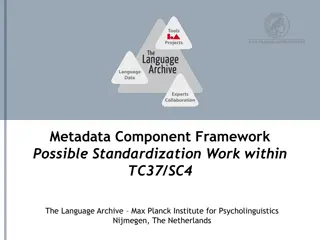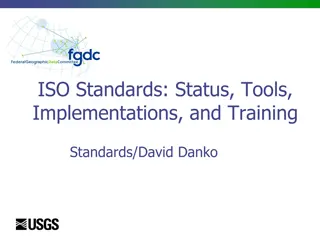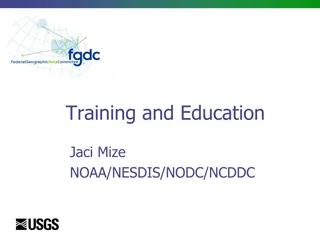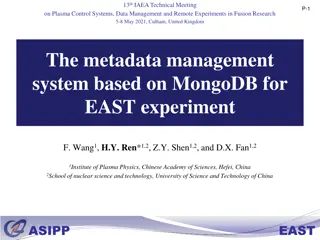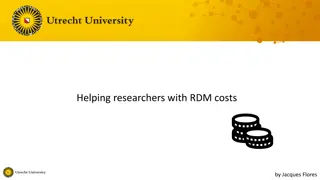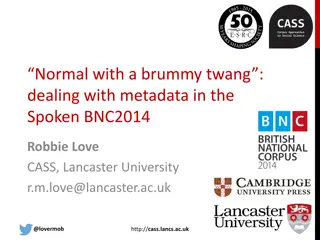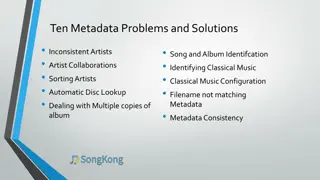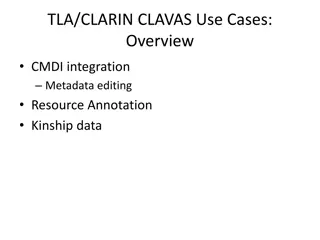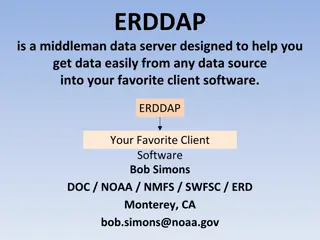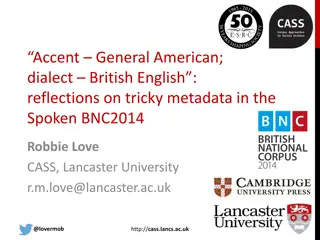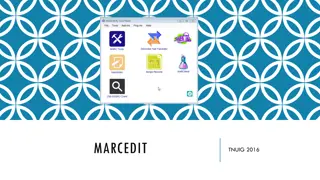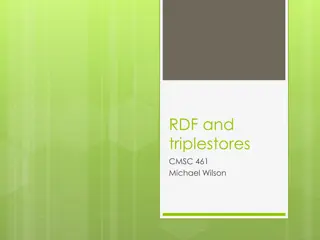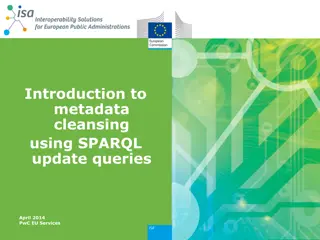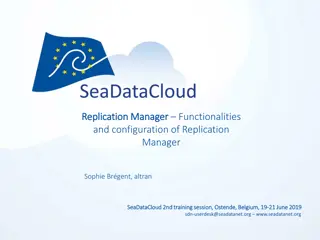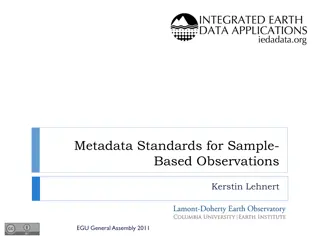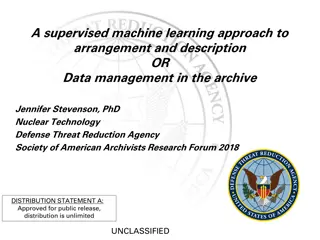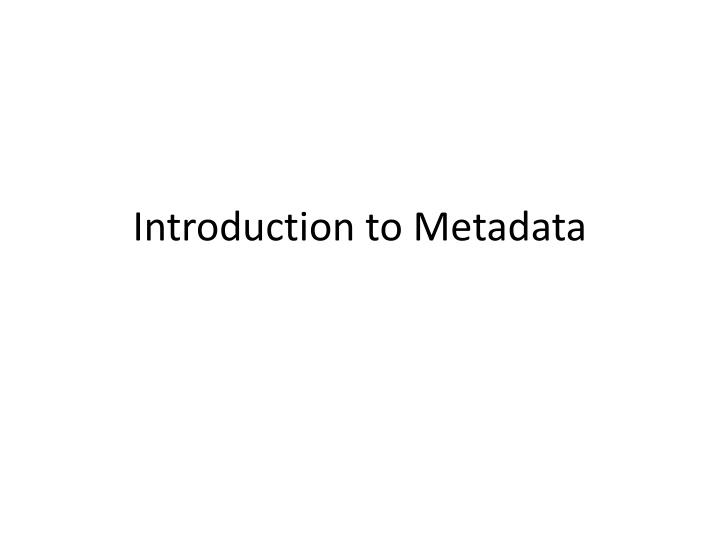
Importance of Metadata in Digital Management
Metadata plays a crucial role in digital asset management, enabling effective organization, discovery, and preservation of digital objects. This article delves into the significance of metadata, its various types, and how it supports digital library objectives. Explore the world of metadata and its essential functions in managing digital collections.
Download Presentation

Please find below an Image/Link to download the presentation.
The content on the website is provided AS IS for your information and personal use only. It may not be sold, licensed, or shared on other websites without obtaining consent from the author. If you encounter any issues during the download, it is possible that the publisher has removed the file from their server.
You are allowed to download the files provided on this website for personal or commercial use, subject to the condition that they are used lawfully. All files are the property of their respective owners.
The content on the website is provided AS IS for your information and personal use only. It may not be sold, licensed, or shared on other websites without obtaining consent from the author.
E N D
Presentation Transcript
Digital Object Is made up of 2 components: The digital asset or bitstream: image, sound, book, audio, data set, etc. It s affiliated metadata ( data about data )
Why Does Metadata Matter? Doing research on the Web is like using a library assembled piecemeal by pack rats and vandalized nightly. (Roger Ebert) How do you find these materials? Audio Images Video Text
Digital library system objectives Metadata must support: Discovery Navigation Presentation Access control Administration & Management Preservation 4
What is Metadata? Is it fancy word for cataloging ? In the standard library world, catalog records are metadata, as they contain information about the library's collection of "data", (i.e. the books, journals, and electronic resources) that make up its collections.
What is Metadata? Metadata is the data that facilitates management, description, and preservation of our digital objects or collections of digital objects. Metadata creation is typically governed by a body of standards, best practices, schema that when used correctly, ensure effective management, description and preservation of digital objects.
What is Metadata? One more definition Metadata is structured information that describes, explains, locates, or otherwise makes it easier to retrieve, use, or manage an information resource.
Type of Metadata Descriptive: facilitating resource discovery and identification Administrative: supporting resource management within a collection Structural: binding together the components of complex information objects Technical: Related to how the system works Use: Related to the level and type of use Preservation: related to the preservation/longevity
Filenaming One of the first metadata events that you do We ve already talked about best practices Also, restrictions placed by the operating systems of what s allowed in the filename
Metadata storage Database Embedded in the file Flat text file XML file XML Database JSON Linked Data (future)
Metadata Standards Communities have specific information needs Interoperability requires standards in order for one community to speak to another In moving from dispersed digital collections to interoperable digital libraries, the most important activity we need to focus on is standards most important is the wide variety of metadata standards [including] descriptive metadata administrative metadata , structural metadata, and terms and conditions metadata Howard Besser
Metadata Element Sets/Standards MARC21: used in libraries Dublin Core (DC): used across disciplines (more later) EAD: (Encoded Archival Description) archives, describes physical collections and some digital MODS (Metadata Object Description Schema) VRA Core (Visual Resources Association) METS (Metadata Encoding and Transmission Standard ) 12
Dublin Core Version 1.1 Vocabulary of 15 field element set for use in digital resource description "Dublin" is due to its origin at a 1995 invitational workshop in Dublin, Ohio suburb of Columbus OCLC based there, and oversees the standard
How and why did the Dublin Core come to be in 1995? Dramatic increase in the number of document-like resources on the net Slow improvement in indexing services made resources hard to discover Belief that descriptive metadata would improve discovery Perceived need for a descriptive standard that was simple to implement (by non-professionals) to create a digital "library card catalog" for the Web. 14
Dublin Core 15 Element Set Creator Title Subject Contributor Date Description Publisher Type Format Coverage Rights Relation Source Language Identifier 15
Interoperability is the ability of a system or a product to work with other systems or products without special effort on the part of the user. to be interoperable, one should actively be engaged in the ongoing process of ensuring that the systems, procedures and culture of an organization are managed in such a way as to maximize opportunities for exchange and re-use of information, whether internally or externally. (Paul Miller) Metadata standards allow for interoperability
Interoperability We seek to avoid silos of information Duplicative metadata creation Reduced efficiency Greater chance for inconsistent description across systems Sometimes a necessary evil
What are Examples of Silos? Integrated Library System (ILS) Institutional Repository Dspace, Fedora, EPrints Various journal vendors (JSTOR, EBSCOetc.) Digital Asset Management Systems Luna or Content DM Learning Management System Blackboard, Sakai Content Management System Drupal, Red Dot, Wordpress
The Rise of MARC MARC (MAchine Readable Cataloging) MARC became a national standard in 1971 First time technology was used to catalog The term mark-up comes from marking up a manuscript . It s information about the information. Not until the advent of SGML/XML was there a clear distinction between markup and the information it was tagging or marking up Henriette Avram
MODS (Metadata Object Description Schema) MODS was developed as a descriptive metadata scheme oriented toward digital objects, and drawing from the MARC 21 Format. Uses XML A derivative of MARC MODS does not assume the use of any specific rules for description Element set is particularly applicable to digital resources Will probably supplant Dublin Core
XML and Metadata XML is the de-facto standard for metadata descriptions on the Internet <root></root> Interoperability and object exchange requires the use of established standards Complex digital objects require many more forms of metadata than analog for their management and use
XML What is XML? EXtensible Markup Language. XML is a set of rules for defining markup languages and describing data. Why XML? XML is a standard means of delivering structured data via Web applications. XML is extensible both a blessing and a burden Authors can define their own tags and attributes, e.g. CML Chemical markup language A well-formed XML file conforms to a set of very strict rules that govern XML. If a file doesn't conform to those rules, XML stops working
MARC versus XML In MARC: 245 04 $a The Big heat <title>Big heat</title> <name>value</name> In XML: MARC XML https://www.loc.gov/standards/marcxml/San dburg/sandburg.xml XML has become the de-facto encoding standard for representing metadata descriptions of digital resources
What about Complex/Hierarchical Objects (Books etc.)?
METS METS is an XML Schema designed for the purpose of creating XML documents that express the hierarchical structure of digital library objects, the names and locations of the files that comprise those objects, and the associated metadata. Puts a virtual wrapper around digital files that need to be held together
Where Metadata is Stored Embedded in the resource itself EXIF, IPTC, XMP or BEXT chunk for audio Spreadsheet Relational Database Flat files Comma Separated Values(.csv) Space or Tab Delimited (.txt) XML Flat file XML database
Metadata Tools Spreadsheets (Excel) Standalone Database (Access) Standalone Web form XML Digital Library Content Management System
Metadata Management Tools Open Refine (formerly Google Refine) is a powerful tool for working with messy data: cleaning it; transforming it from one format into another; and extending it with web services and external data. OpenWMS: The OpenWMS is a platform-independent, open source, web-accessible system that can be used as a standalone application or integrated with other repository architectures by a wide range of organizations. It provides a complete metadata creation system for analog and digital materials, with services to ingest objects and metadata into a Fedora repository and to export these objects and metadata, individually and in bulk in METS/XML Wrapper
Rules for Description Vocabularies AACR RDA Genre AAT (Art and Architecture Thesaurus) Rules for Archival Description RAD (Rules of Archival Description) DACS (Describing Archives Content Standard)

